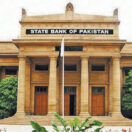By Shahbaz Rana
Published in The Express Tribune on February 17, 2022
ISLAMABAD: A legislative panel of the National Assembly on Wednesday approved amendments to the Fiscal Responsibility and Debt Limitation (FRDL) Act to relax the condition to reduce the debt to a sustainable level for 10 years after the government constantly violated the law.
The National Assembly Standing Committee on Finance and Revenue unanimously approved the FRDL (Amendment) Act 2021.
According to the revised draft, the condition to keep public debt below 60% of the size of economy has been relaxed for 10 years.
The new statutory deadline for achieving the sustainable debt level of 60% is now fiscal year 2026-27 against fiscal year 2016-17 earlier.
The bill will now be tabled in the National Assembly for a final vote. “Ensuring that over next six years, after financial year 2020-21, the total public debt share shall be reduced to 60% of the estimated gross domestic product (GDP),” said Clause 3(3) b of the FRDL bill.
The 60% threshold had to be achieved in fiscal year 2016-17. But not only the PML-N government, but also the Pakistan Tehreek-e-Insaf (PTI) government has violated this clause since coming to power.
Over the past three and a half years, the PTI government has come in for severe criticism for contracting expensive foreign debt and increasing the debt pile to a highly unsustainable level of over Rs41 trillion.
The standing committee also approved another crucial amendment that will now bind the government to seek fresh approval of the National Assembly, if it does not reduce the debt-to-GDP ratio by 2% every year for three consecutive years. Earlier, there was no such limit.
The clause for seeking fresh parliamentary approval was proposed by Syed Naveed Qamar of the Pakistan Peoples Party (PPP), which was also endorsed by committee Chairman Faizullah Kamoka of the PTI.
Qamar had also proposed that there should be a complete ban on government borrowing, if the debt-to-GDP ratio remained above a certain threshold. But Debt Office Director Umar Tarin opposed the amendment.
Before the rebasing of economy, the total public debt-to-GDP ratio was 83.5% at the end of third year of the PTI government. However, after the rebasing, the debt-to-GDP ratio will fall to 72%.
A new debt policy statement for the last fiscal year that the government submitted in the cabinet revealed that the federal government’s burden was Rs11.8 trillion higher than the legally allowed limit set by parliament.
“The ratio remained higher than the threshold of 59% (Rs28.1 trillion) targeted to be achieved by fiscal year 2020-21, as stipulated in the FRDL Act”, said the finance ministry in the report.
Subsequently, the finance ministry changed the goalposts in the fiscal policy statement that was submitted to the National Assembly and used a new base year number, which has not yet been formally approved by all relevant forums.
PTI is not the only government that has been violating the FRDL law. PPP and PML-N governments too were in violation of the FRDL Act that had been enacted to ensure fiscal discipline in 2005.
But the difference between the PTI and the other two political parties was that Prime Minister Imran Khan had said in February 2019 that one benchmark of the success of his government would be the reduction in public debt to Rs20 trillion.
The committee approved another amendment, according to which the limit to further reduce public debt below 60% of GDP was relaxed for 10 years.
“Ensuring that, after financial year 2026-27, the total public debt shall be reduced by 1% every year, to reduce it to 50% of GDP by financial year 2036-37 and thereafter maintaining it at that level or less than that.” Earlier, this level had to be achieved by fiscal year 2026.
The standing committee approved another change that would allow the government to issue sovereign guarantees equal to 10% of GDP. PML-N’s MNA Dr Ayesha Pasha objected to setting the limit at 10%, saying it was against prudent fiscal management.
Although there was no maximum legally binding limit on the stock of sovereign guarantees, the government was limiting it to around 6% of GDP under a condition imposed by the International Monetary Fund (IMF).
The government has also closed the door for deviation from the path of sound fiscal management in case of “national security or natural calamity”.
This clause has been omitted from the bill approved by the National Assembly committee. Under the IMF condition, the door to borrowing from the SBP is already permanently shut.
The government has legally strengthened the debt management office, which at this point in time remains very weak due to the strong footprint of the Q-block bureaucracy in it.
Within 60 days of the commencement of FRDL (Amendment) Act 2021, the federal government shall, by notification in the official gazette, establish an office to be known as debt management office, consisting of four executives including a director general and three directors.
Directors shall report to the director general and the director general shall report to the secretary, Finance Division, according to the bill.
In line with the World Bank conditions, the debt management office has been given vast powers to maintain authenticated public debt record, prepare annual debt reviews, annual borrowing plan, raise domestic and external debt and keep record of the sovereign guarantees.






